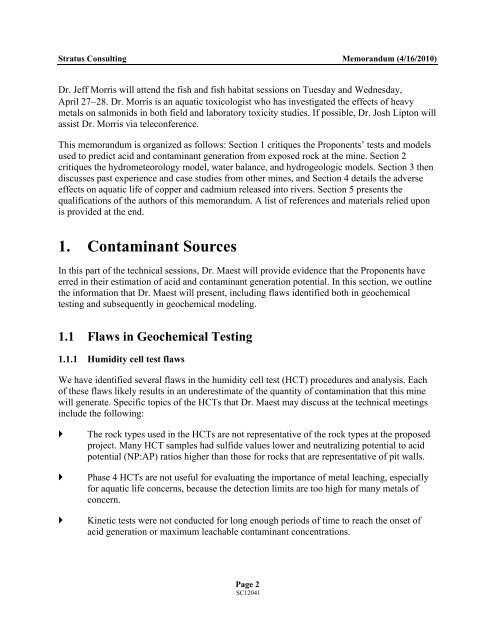From: on behalf of Panel Registry Subject: FW: TNG registration of ...
From: on behalf of Panel Registry Subject: FW: TNG registration of ...
From: on behalf of Panel Registry Subject: FW: TNG registration of ...
Create successful ePaper yourself
Turn your PDF publications into a flip-book with our unique Google optimized e-Paper software.
Stratus C<strong>on</strong>sulting Memorandum (4/16/2010)<br />
Dr. Jeff Morris will attend the fish and fish habitat sessi<strong>on</strong>s <strong>on</strong> Tuesday and Wednesday,<br />
April 27�28. Dr. Morris is an aquatic toxicologist who has investigated the effects <strong>of</strong> heavy<br />
metals <strong>on</strong> salm<strong>on</strong>ids in both field and laboratory toxicity studies. If possible, Dr. Josh Lipt<strong>on</strong> will<br />
assist Dr. Morris via telec<strong>on</strong>ference.<br />
This memorandum is organized as follows: Secti<strong>on</strong> 1 critiques the Prop<strong>on</strong>ents’ tests and models<br />
used to predict acid and c<strong>on</strong>taminant generati<strong>on</strong> from exposed rock at the mine. Secti<strong>on</strong> 2<br />
critiques the hydrometeorology model, water balance, and hydrogeologic models. Secti<strong>on</strong> 3 then<br />
discusses past experience and case studies from other mines, and Secti<strong>on</strong> 4 details the adverse<br />
effects <strong>on</strong> aquatic life <strong>of</strong> copper and cadmium released into rivers. Secti<strong>on</strong> 5 presents the<br />
qualificati<strong>on</strong>s <strong>of</strong> the authors <strong>of</strong> this memorandum. A list <strong>of</strong> references and materials relied up<strong>on</strong><br />
is provided at the end.<br />
1. C<strong>on</strong>taminant Sources<br />
In this part <strong>of</strong> the technical sessi<strong>on</strong>s, Dr. Maest will provide evidence that the Prop<strong>on</strong>ents have<br />
erred in their estimati<strong>on</strong> <strong>of</strong> acid and c<strong>on</strong>taminant generati<strong>on</strong> potential. In this secti<strong>on</strong>, we outline<br />
the informati<strong>on</strong> that Dr. Maest will present, including flaws identified both in geochemical<br />
testing and subsequently in geochemical modeling.<br />
1.1 Flaws in Geochemical Testing<br />
1.1.1 Humidity cell test flaws<br />
We have identified several flaws in the humidity cell test (HCT) procedures and analysis. Each<br />
<strong>of</strong> these flaws likely results in an underestimate <strong>of</strong> the quantity <strong>of</strong> c<strong>on</strong>taminati<strong>on</strong> that this mine<br />
will generate. Specific topics <strong>of</strong> the HCTs that Dr. Maest may discuss at the technical meetings<br />
include the following:<br />
�� The rock types used in the HCTs are not representative <strong>of</strong> the rock types at the proposed<br />
project. Many HCT samples had sulfide values lower and neutralizing potential to acid<br />
potential (NP:AP) ratios higher than those for rocks that are representative <strong>of</strong> pit walls.<br />
�� Phase 4 HCTs are not useful for evaluating the importance <strong>of</strong> metal leaching, especially<br />
for aquatic life c<strong>on</strong>cerns, because the detecti<strong>on</strong> limits are too high for many metals <strong>of</strong><br />
c<strong>on</strong>cern.<br />
�� Kinetic tests were not c<strong>on</strong>ducted for l<strong>on</strong>g enough periods <strong>of</strong> time to reach the <strong>on</strong>set <strong>of</strong><br />
acid generati<strong>on</strong> or maximum leachable c<strong>on</strong>taminant c<strong>on</strong>centrati<strong>on</strong>s.<br />
Page 2<br />
SC12041
















